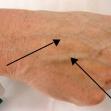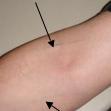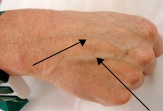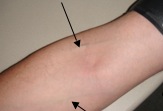Patient Assessment
Consideration
Consider the following
- Age of patient, children are difficult to cannulate while elderly may have fragile veins
- Previous cannulation and condition of the veins
- Clinical status of the patient e.g. Dehydrated, shock, amputee, mastectomy, oedema, thrombocytopenia, CVA
- Other clinical procedures required during admission
- Type and length of treatment
- Current medications: warfarin, heparin, steroids
- Patient preference
- Patient co-operation, previous experiences
- Try to use non-dominant arm
Cannulation sites:
- Median antecubital veins,
- Forearm veins,
- Dorsum of hands
- In difficult patients, dorsum of the foot.
|
Dorsum veins |
Anticubital veins |
Questions to ask the patient
![]()
- Have you had a cannula/blood test before?
- Were there any complications / adverse reactions?
- Do you have any allergies?
- Do you take any medications?
- Consider needle phobia/fainting
- Would you like a local/topical anaesthetic before insertion of the cannula or take blood?
- Which is your dominant arm?
Explain the procedure
Explain the procedure to the patient. Inform the patient that the procedure may be slightly painful. Emphasize that the patient should hold the extremity completely still until the completion of the cannulation. Be patient to answer any questions that the patient might have.
Explain that the patient should be lying on the bed should the patient faints during the procedure.
Vein selection
A good vein is:
- Bouncy
- Soft
- Refills when depressed
- Visible
- Has a large lumen well supported and straight
A bad vein is:
- Thrombosed / sclerosed / fibrosed
- Inflamed / bruised,painful
- Hard to palpate
- Thin / Fragile
- Mobile / tortuous
- Near bony prominences,
- Areas or sites of infection, oedema or phlebitis
- In the lower extremities (unless none else available)
- Have undergone multiple previous punctures
Improve visibility

- Application of a tourniquet promotes venous distension. The tourniquet should be applied 10-15 cm proximal to puncture site and should be tight enough to impede venous return but not affect arterial flow.
Lower the extremity below the level of the heart
Use muscle action to force blood into the veins - e.g. open and closing of the fist
Light tapping of the vein with fingertips
Apply warm compresses or immerse limb in a bowl of hot water to increase vasodilatation
Consider GTN Patch








